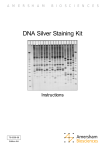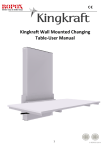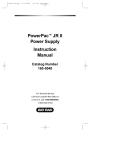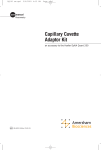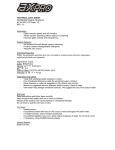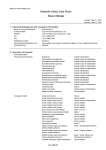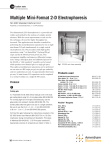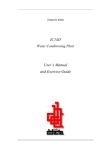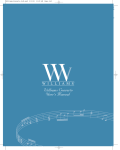Download マニュアル GeneGel HyRes Starter Kit
Transcript
Hyres_um.qxd 4/29/02 3:16 PM Page cvr1 user manual DNA fragment analysis GeneGel HyRes Starter Kit for high-resolution electrophoretic DNA typing um 80-6452-59/Rev. B0/04-02 Hyres_um.qxd 4/29/02 3:16 PM Page isc2 Hyres_um.qxd 4/29/02 3:16 PM Page i Page finder Introduction . . . . . . . . . . . . . . . . . . . . . . . . . . . . . . ii Preparing samples and standards . . . . . . . . . . . . . . . . 2 Preparing solutions . . . . . . . . . . . . . . . . . . . . . . . .2 Preparing samples for native gels . . . . . . . . . . . . . .3 Preparing samples for denaturing gels . . . . . . . . . . .3 Preparing gels ............................4 Electrophoresis . . . . . . . . . . . . . . . . . . . . . . . . . . . . 6 Preparing the electrode wicks . . . . . . . . . . . . . . . . .7 Loading the samples . . . . . . . . . . . . . . . . . . . . . . .8 Running conditions . . . . . . . . . . . . . . . . . . . . . . .9 Detection . . . . . . . . . . . . . . . . . . . . . . . . . . . . . . . 10 Product information . . . . . . . . . . . . . . . . . . . . . . . . 11 • pi Hyres_um.qxd 4/29/02 3:16 PM Page ii GeneGel Hyres Starter Kit • introduction Introduction The GeneGel HyRes Starter Kit provides materials for the highest resolution DNA separation on the GenePhor™ electrophoresis unit. The kit is suitable for a variety of electrophoretic analyses, including: variable number tandem repeats (VNTR); low-complexity differential display reverse transcription (DDRT); and most short tandem repeat (STR) analysis. With a separation range of 40–250 bp, the GeneGel HyRes Denaturing gels provide 2–4 bp resolution in as little as 2.5 h total separation and detection time. GeneGel HyRes Native gels require 4 h total separation and detection time. The GeneGel HyRes Starter Kit contains pre-cast dry gels for both native and denaturing applications. The native gels offer high-resolution of ds DNA fragments. The denaturing gels are comparable to a sequencing gel format for the separation of ss DNA fragments. Rehydrate each gel with its respective Rehydration Buffer and soak the included electrode wicks in the corresponding Electrode Buffer. The combination of the electrode and gel rehydration buffers form discontinuous buffer systems designed for efficient DNA separations. Use the GeneGel HyRes Starter Kit with the GenePhor Electrophoresis Unit. Following separation, we recommend using the Hoefer™ Processor Plus together with the PlusOne DNA Silver Staining Kit for high-sensitivity gel staining. The plastic backing on all GeneGel gels allows the stained gel to be easily handled and dried for accurate evaluation and permanent documentation of results. um 80-6452-59 • pii Hyres_um.qxd 4/29/02 3:16 PM Page 1 • components Components Warning! For research use only. Not recommended or intended for the diagnosis of disease in humans or animals. Do not use internally or externally in humans or animals. Gels: 3 GeneGel HyRes Native gel, 0.65 mm (after rehydration) 2 GeneGel HyRes Denaturing gel, 0.43 mm (after rehydration) Buffers: GeneGel HyRes Native Rehydration Buffer, with bromophenol blue, 75 ml GeneGel HyRes Denaturing Rehydration Buffer, 45 ml GeneGel HyRes Native Electrode Buffer, 40 ml GeneGel HyRes Denaturing Electrode Buffer, 30 ml Electrode Wicks: 40 GeneGel Standard Electrode Wicks 5 Gel drying boards Other materials required Handling (not supplied with this kit) Storage: Store the buffers at ambient temperature. Store the gels at +4–8 °C. Formamide (code 17-1320-01) Xylene cyanol dye Bromophenol blue (code no. 17-1329-01) 100 Base-pair Ladder, recommended (code 27-4007-01) Kerosene Urea (for GeneGel HyRes Denaturing gel) Forceps Rotating shaker platform Rehydration tray (code 18-1117-60) Expiry: Please refer to the kit packaging. • p1 Hyres_um.qxd 4/29/02 3:16 PM Page 2 GeneGel Hyres Starter Kit • preparing samples and standards Preparing samples and standards Note: The maximum loading volume of the wells in GeneGel HyRes gels is 4 µl. The sensitivity of the detection method you plan to use determines the minimum amount of sample that can be used. When possible, samples should be diluted with sample buffer to yield 6 ng of each DNA fragment present in a 4-µl loading volume. Use this as a guideline when using silver staining for detection. Preparing solutions Prepare the following solutions for use in diluting samples and standards. 0.1 M EDTA 1.0 g EDTA disodium salt Dissolve and make up to 25 ml with distilled water. 1% (w/v) xylene cyanol or bromophenol blue solution 0.1 g solid xylene cyanol or bromophenol blue Dissolve and make up to 10 ml with distilled water. Sample buffer for native gels (5 ml total volume) 4.94 ml Native Gel Rehydration Buffer 8 µl xylene cyanol solution (1%) 50 µl EDTA solution (0.1 M) Denaturing solution (25 ml total volume) Combine: 23.75 ml formamide 0.625 ml 1% xylene cyanol solution 0.625 ml 1% bromophenol blue solution May be stored up to 12 months at 4–8 °C. um 80-6452-59 • p2 Hyres_um.qxd 4/29/02 3:16 PM Page 3 • preparing samples and standards Preparing samples for native gels Note: To avoid overloading, the recommended total amount of DNA in a 4-µl sample volume should not exceed 0.2 µg. 1 If necessary, dilute the sample with sample buffer (see page 2). 2 For size standard, dilute the GE Healthcare 100 Basepair ladder (code no. 27-4007-01). The recommended load is 150–200 ng per well. Preparing samples for denaturing gels Note: To avoid overloading, the recommended total amount of DNA in a 4-µl sample volume should be between 0.5 µg and 1 µg. To dilute samples and standards 1 If necessary, dilute the sample with denaturing solution (see page 2). 2 For size standard, dilute the GE Healthcare 100 Basepair ladder (code no. 27-4007-01). The recommended load is 150–200 ng per well. 3 Mix the samples thoroughly and heat them 3–5 min to 95 °C. Chill samples in an ice water bath before applying to the gel. • p3 Hyres_um.qxd 4/29/02 3:16 PM Page 4 GeneGel Hyres Starter Kit • preparing gels Preparing gels Important! Avoid excessive folding or bending of GeneGel HyRes gels. These instructions can be used to rehydrate either HyRes Native or HyRes Denaturing gels. Be sure to use the appropriate rehydration buffer. Rehydrating native gels Use GeneGel HyRes Native Rehydration Buffer, as supplied, to rehydrate native gels. Rehydrating denaturing gels Place 8.4 g urea (7 M) in a beaker and add 13.5 ml GeneGel HyRes Denaturing Rehydration Buffer. Mix thoroughly. Use this solution with GeneGel HyRes Denaturing gels. 1 Pipette 20 ml of rehydration buffer into the rehydration tray. 2 Fig 1. Lower the film with the gel surface downward into the rehydration buffer. Open the gel package by cutting along two sides of the package. Remove the gel from the package and remove the plastic covering sheet covering the gel. 3 Set one edge of the film with the gel surface downward into gel rehydration buffer (Fig 1). Slowly lower the rest of the gel film into the buffer. Take care to avoid trapping air bubbles. 4 To distribute the buffer evenly, lift the other side of the film using forceps and lower it once more into the buffer, again taking care to avoid trapping air bubbles under the gel (Fig 2). Fig 2. For even buffer distribution, carefully lift the opposite side of the film. um 80-6452-59 • p4 Hyres_um.qxd 4/29/02 3:16 PM Page 5 • preparing gels 5 Note: The HyRes Native gel is made of a proprietary polyacrylamide matrix. It is slightly thicker and more brittle than the HyRes Denaturing gel. To assure even rehydration and prevent the gel from sticking to the chamber, place the rehydration tray on a rotating shaker for 90 minutes at a vigorous rotation rate (80 rpm). During agitation, the gel should bump against the walls of the rehydration tray. After 90 minutes, the gel will have swelled to a final thickness ≥0.5 mm. 6 After rehydration, remove the gel from the rehydration tray and place it, gel-side up, on filter paper. Important! The gel surface must be free of droplets before beginning electrophoresis. 7 To remove excess buffer, gently place the gel on the benchtop. Use the edge of a gel drying board to wipe buffer off the gel surface (Fig 3) until a squeaking sound is produced from the wiping of the drying board against the gel surface (approximately 2–3 wipes). The gel is now ready to use for electrophoresis. Fig 3. Dry the surface of the rehydrated gel with the edges of a gel drying board. • p5 Hyres_um.qxd 4/29/02 3:16 PM Page 6 GeneGel Hyres Starter Kit • electrophoresis Electrophoresis Important! When using the GeneGel HyRes gels, remove the acrylic buffer strip positioner from the GenePhor Electrophoresis Unit during the run to prevent condensation on the gel. Note: Wear gloves when handling the gels to avoid contamination, particularly when using sensitive silver stains. 1 Switch on the GenePhor Electrophoresis Unit and set to the recommended temperature. 2 Pipette about 0.5 ml of insulating fluid (kerosene) onto the center of the cooling plate of the GenePhor Electrophoresis Unit. Use tissue paper to spread it evenly over the surface. 3 Using the grid on the cooling plate as a guide, position the gel in the center of the cooling plate with the sample wells at the cathode side (Fig 4). Avoid trapping air bubbles under the gel. 4 To prevent drying, apply the electrode wicks as soon as possible. Fig 4. Positioning the gel with sample wells at cathode. um 80-6452-59 • p6 Hyres_um.qxd 4/29/02 3:16 PM Page 7 • electrophoresis Preparing the electrode wicks 1 Place two stacks of four standard electrode wicks each on any hard, flat non-absorbent surface, such as a glass plate or dish. 2 Use a pipette to apply 6 ml of the appropriate electrode buffer to each stack of electrode wicks (Fig 5). Use GeneGel HyRes Native Electrode Buffer with native gels. Use GeneGel HyRes Denaturing Electrode Buffer with denaturing gels. Fig 5. Wetting electrode wicks with electrode buffer. 3 After thoroughly wetting the electrode wicks, stroke them with the tip of a bent forceps to distribute the buffer evenly and remove air bubbles. Blot the electrode wicks on a paper towel to remove excess buffer. 4 Place one stack of electrode wicks on the gel, near the cathodic (–) end of the GenePhor cooling platform and place the other stack of wicks on the gel at the anodic (+) end. • p7 Hyres_um.qxd 4/29/02 3:16 PM Page 8 GeneGel Hyres Starter Kit • electrophoresis Loading the samples Important! Wipe the platinum electrode wires before and after each electrophoresis run with wet tissue paper. Important! Do not use the buffer strip positioner with GeneGel HyRes gels. See page 6. 1 Prepare the samples according to the directions on page 3. Use a pipette to load the recommended 4 µl of sample or size standard into each well (Fig. 6). 2 Lower the electrode lid onto the electrode wicks. Verify that the electrodes come in even contact with the stacks of electrode wicks. 3 Lower the safety lid until it clicks shut. Connect the power supply. 4 Set the power supply to the recommended values (Table 1, Table 2, or Table 3) and press Start. 5 Check the current reading to verify power is properly connected (milliamps greater than 0). 6 If using a denaturing gel, at the end of phase 1, switch off the power supply. Open the safety lid and the electrode holder plate. Fig 6. Loading samples with a pipette. um 80-6452-59 • p8 Place the polyester film over the gel surface between the two stacks of electrode wicks to prevent gel drying. Close the electrode holder plate and the safety lid. Continue with phase 2. Hyres_um.qxd 4/29/02 3:16 PM Page 9 • electrophoresis Running conditions Native gels Important! When using the GeneGel HyRes gels, remove the acrylic buffer strip positioner from the GenePhor Electrophoresis Unit during the run to prevent condensation on the gel. Note: Determine the optimal run time, based on the size of the fragments of interest. Table 1 gives recommended settings and running conditions for use with GeneGel HyRes Native Gels. Table 1. Running conditions— HyRes Native Electrode Buffer temperature max. voltage max. current max. watts time* Phase 1 12 °C 180 V 22 mA 5W 40 min Phase 2 12 °C 390 V 26 mA 11 W 75 min *For 40–200 bp fragments, set Phase 2 to 75 min. At the end of this time, the bromophenol blue front reaches the anode. *For 100–300 bp fragments, set Phase 2 to 130 min. At the end of this time, the xylene cyanol front reaches the anode. *For 200–400 bp fragments, set Phase 2 to 200 min. At the end of this time, the xylene cyanol front is projected to be 1 cm past the anode. Denaturing gels Important! When using the GeneGel HyRes gels, remove the acrylic buffer strip positioner from the GenePhor Electrophoresis Unit during the run to prevent condensation on the gel. Note: Total running time for denaturing gels should not exceed 90 minutes. Table 2 gives recommended settings and running conditions for use with GeneGel HyRes Denaturing Gels. During sample loading, set the temperature to 20 °C. Table 2. Running conditions with HyRes Denaturing Electrode Buffer temperature max. voltage max. current max. watts time* Phase 1 40 °C 100 V 10 mA 5W 10 min After Phase 1, cover the gel with a sheet of polyester film. Phase 2 50 °C 300 V 12 mA 10 W 45 min* *After 55 min electrophoresis, the bromophenol blue and 70-base fragments reach the anode. Xylene cyanol runs with 100-base fragments. • p9 Hyres_um.qxd 4/29/02 3:16 PM Page 10 GeneGel Hyres Starter Kit • detection Detection Important! Immediately cover GeneGel HyRes Native gels after air drying for 1 hour. These gels become brittle and shatter with excessive drying. For reproducible and sensitive silver staining, use the Hoefer Processor Plus with gel staining trays and the PlusOne™ DNA Silver Staining Kit. Because of the special matrix of the GeneGel HyRes Native gels and the high concentration of urea used with the GeneGel HyRes Denaturing gels, we recommend the modifications shown in Table 3. After air drying the stained gels, cover them with polyester film and store at room temperature. Table 3. Modified Silver Staining of GeneGel HyRes Gels um 80-6452-59 • p10 step time (min) solution 1. Fixing 40 175 ml 0.6% Benzene sulphonic acid in 24% (v/v) ethanol 2. Wash 3 × 10 175 ml 0.06% Benzene sulphonic acid (dilute 5X Fix 1:50 in distilled H2O) 3. Silver solution 40 175 ml 0.2% (w/v) AgNO3 0.07% benzenesulphonic acid 4. Wash 2 175 ml distilled H2O 5. Developing 7 175 ml 2.5% Na2CO3 175 µl 37% formaldehyde 175 µl 2% sodium thiosulfate 6. Stop/preserve solution 20 175 ml 1.0% (v/v) Acetic acid + 5% sodium acetate + 10% glycerol Hyres_um.qxd 4/29/02 3:16 PM Page 11 • product information Product information product code no. GeneGel HyRes Starter Kit 80-6451-07 GeneGel HyRes Native Gels 80-6451-26 GeneGel HyRes Denaturing Gels 80-6451-45 GeneGel HyRes Native Buffer Kit Includes Rehydration buffer, Electrode buffer, electrode wicks (40), drying boards (5) 80-6451-64 GeneGel HyRes Denaturing Buffer Kit Includes Rehydration buffer, Electrode buffer, electrode wicks (40), drying boards (5), polyester film 80-6451-83 GeneGel Standard Electrode Wicks 80-6452-02 GenePhor Electrophoresis unit 18-1115-82 Related products EPS 1001 Power Supply 18-1130-03 Hoefer Processor Plus, base unit Includes pump, reagent tubing, protocol key 80-6444-04 Gel Staining Tray Pack (19 × 29 cm) Includes tray support, PTFE-coated staining tray, lid, magnets, gasket, level and Gel Staining Protocol Guide 80-6444-80 PlusOne DNA Silver Staining Kit 17-6000-30 100 Base-pair Ladder, 1 µg/µl in TE buffer, 100 µg 27-4007-01 • p11 Hyres_um.qxd 4/29/02 Notes: um 80-6452-59 • p12 3:16 PM Page 12 Hyres_um.qxd 4/29/02 3:16 PM Page isbc1 Hyres_um.qxd 4/29/02 3:16 PM Page bc1 GenePhor, Hoefer and PlusOne are trademarks of GE Healthcare Bio-Sciences Ltd. GE Healthcare is a trademark of General Electric Company. All goods and services are sold subject to the terms and conditions of sale of the company within the General Electric Company group that supplies them. A copy of these terms and conditions is available on request. Printed in the USA. GE Healthcare UK Ltd GE Healthcare Place, Little Chalfont, Buckinghamshire, England HP7 9NA GE Healthcare Bio-Sciences AB SE-751, 84 Uppsala, Sweden GE Healthcare Bio-Sciences Corp. 800 Centennial Avenue, PO Box 1327, Piscataway, NJ 08855 USA GE Healthcare Europe GmbH Munzinger Strasse 9, D-79111, Freiburg, Germany GE Healthcare Bio-Sciences (SF) Corp. 654 Minnesota Street, San Francisco, CA 94107 USA www.gehealthcare.com/lifesciences



















